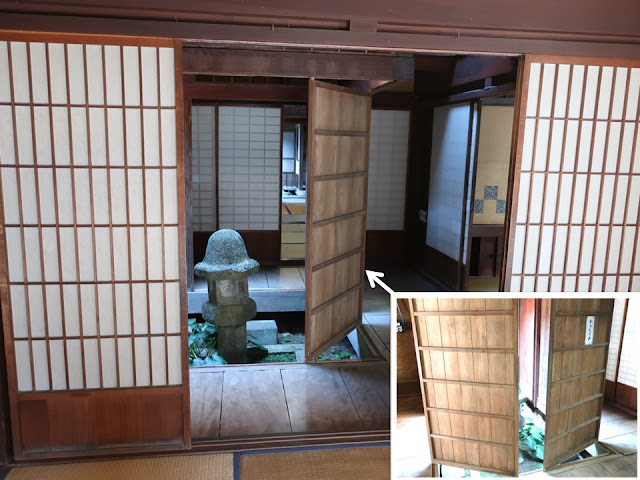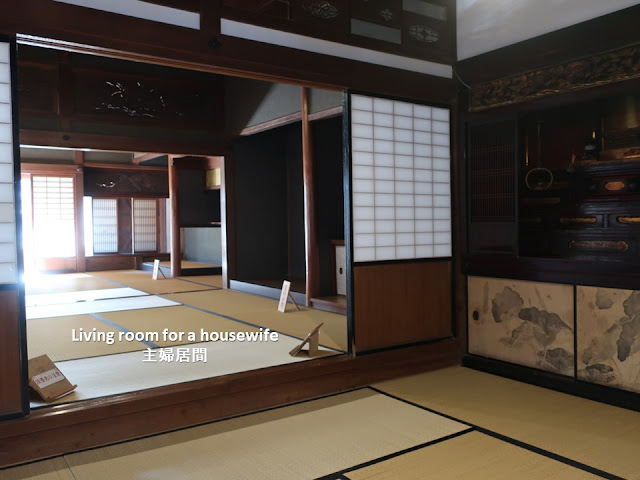Fukiya town is the birthplace of red iron oxide (pigment) which is called “Japan-red” (“Bengala” in Japanese). The town flourished around 1900 by the production of Japan-red and copper. It is a classy town in a mountainous area, but many people lived including prostitutes back then.
ベンガラ作りで巨大な富を築いた岡山県北部の吹屋を訪ねました。“「ジャパンレッド」発祥の地 -弁柄(ベンガラ)と銅(あかがね)の町・備中吹屋-”として、日本遺産に登録されています。いい感じの街ですよ。明治時代に隆盛を極め、遊女がいるほど栄えた街でした。
Roof tiles and exterior are painted in Japan-red” and are attractive. I'm afraid the blue sky is much more attractive than Japan-red roof.
瓦や格子、ベンガラ色が映える街ですね。青空が映えすぎますかね?
Fukiya Folk Museum、郷土館
The museum was built in 1879 by the temple carpenter who came from the neighboring prefecture (Shimane).
片山家の分家。石州大工によって明治12年(1879)に竣工しました。
It is a long house to the back which is a typical style of a merchant one. Everyday goods are displayed in the house.
奥に長い商家の作りです。民具等が展示されています。
How do you like the wooden partitions (lower right)? Those are folded and are put away. They can choose an open space or a closed one. We also use sliding doors; Japanese houses are flexible.
からくり戸、いかがでしょうか。折りたためます。他の人を見せる時、見せない時、日本家屋はフレキシブルですね。
Former Katayama Family Residence、旧片山家住宅
Katayama family was a premier manufacturer and distributor of Japan-red pigment. They continued their business until 1971 while chemical paints were growing.
ベンガラの製造販売をしていた商家です。化学塗料が伸びる中、1971年まで製造を続けていました。
There is an egg storage next to the kitchen space. Egg, which is inexpensive now, was too precious to eat except for in time of illness back then. The room is at a cooler place.
玄関先の土間の横にあるのが「卵部屋」。病気した時にしか食べられない貴重品であった卵を保存する涼しい部屋でした。今や物価の優等生なのですが。
There is a small window between the maid room and the dining one. The master in the dining room directed the timing of serving dishes through the window. It was the first time for me to see the window like that.
女中居間と食事部屋の間ののぞき窓は、食事の進み具合を見て、主から料理を出すタイミングの指示を受けるための窓だそうです。初めて見ました。
There is a room of Buddhist altar near the road. Then, there are a living room for a housewife and a guest room. A housewife occupied a good space.
道に近い方から、仏間、主婦居間、奥座敷と続きます。主婦はいい場所にいました。
The steep staircase behind the sliding door leads to the second floor.
二階への急な階段は、襖を開けた先にあります。二階は家族のスペースです。
The floor of the bed room for a master and a mistress (upper left) is raised. Even an invader couldn’t give his sword a flourish because of the low ceiling. I feel sorry for the master who had to be anxious about an attack. He was rich, however, it was not certain he was happy.
当主夫婦の寝室は、床を上げています。天井を低くして暴漢が刀を振り回しにくいようにしたのだそうです。考えさせられますねえ。そこまでしなくても。
Behind the main building, there is a factory and a storehouse. Photos of childlike employees are displayed. They were not rich, but they could sleep well, I guess.
奥には、ベンガラを計量して包装する工場建物や蔵がありました。片山家のために働いたあどけない作業員の写真も展示されています。彼らは豊かではなかったと思いますが、暴漢に襲われる心配をせずに眠れたと思います。
I had a lunch (lower left) at an old restaurant; it was a tempura rice bowl with a nyumen (noodle).
Fukiya is a calm town now. However, it
prospered as a production center of pigment and copper. The town was a starting
point of Fukiya highway which linked to a river port (Nariwa). Products were
transported to Tamashima port in Seto Inland Sea, and delivered to all over
Japan.
昼食は古民家の松栄館さんで、にゅうめん付きのかき揚げ丼をいただきました。
山間の静かな観光地ですが、かつては産業の町として吹屋街道の出発点となり、たいへん繁栄しました。ベンガラは成羽から川船で玉島港に運ばれ、各地に輸送されました。
Visited in November, 2022
Official website (吹屋ふるさと村) https://www.city.takahashi.lg.jp/soshiki/9/fukiya4240131.html (in Japanese), accessed in April, 2023
Previous post (castle and its city in the same city): Bitchu Matsuyama Castle and
its town、備中松山城と岡山県高梁市
Next post (museum in the same town): Hirokane mansion and Bengara museum、広兼邸とベンガラ館













Comments
Post a Comment